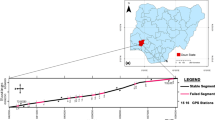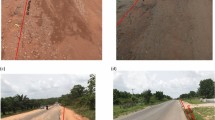Abstract
High records of road accidents due to bad roads and failure of other engineering structures globally have necessitated this study. Geophysical investigation was carried out on six failed sections and two stable ones along the Ibadan-Iwo-Osogbo highway to examine the geological factors responsible for the highway failure in the area. A Landsat ETM+ (Enhanced Thematic Mapper Plus) imagery of the study area and its environs was acquired and processed for lineament analyses. Magnetic and Very Low Frequency Electromagnetic (VLF-EM) measurements were taken at a 5 m interval along each traverse established parallel to road pavements. The electrical resistivity method involving Schlumberger Vertical Electrical Sounding (VES) and 2-D imaging using the dipole–dipole array were utilized. Lineaments were identified across failed localities. Lateral magnetic variations in the near-surface, geologic materials characterized the study area. The generated 2-D VLF-EM models showed conductive zones corresponding to the fractured zones or conductive clay materials within the basement rocks. Subgrade soils below the highway pavement along the failed sections are typical of incompetent clayey and sandy clay/clayey sand formation with resistivity values between 20 and 475 Ωm, while subgrade soils beneath the stable sections have moderate to high resistivity values of 196–616 Ωm. The 2-D subsurface resistivity structures across the failed sections identified low resistivity, water absorbing clay, and lithological contacts. Water absorbing clay-enriched subgrade soils, identified in near-surface linear features, are major geologic factors, along with a poor drainage network, causing the highway failure. Remote sensing and geophysical investigations of highways should be carried out before construction to effectively complement routine geotechnical studies.
Access provided by Autonomous University of Puebla. Download conference paper PDF
Similar content being viewed by others
Keywords
1 Introduction
Road transport is the most commonly used means of transportation in Nigeria, but the rate at which these roads, including highways, failed has increased tremendously in recent times, and this has called for immediate attention of almost everybody. Roads play an important role in trade and transportation systems throughout the world as they serve as links between towns, states, and countries. However, Nigerian roads are relatively unsafe due to their deplorable state, with incessant losses of lives and properties.
Nigeria is among the countries with the highest records of road accidents in the world, contributing by one fifth of the 3,500 daily road accidents in the world [1]. The Federal Road Safety Commission (FRSC) was established to caution drivers so as to reduce the incidence of road accidents. However, most crashes are due to the deplorable state of roads in Nigeria,hence, there is need to identify the causes of road failure and find a means of ameliorating the problem. This research attempts to find out the cause(s) of persistent pavement failure along the Ibadan-Iwo-Osogbo Highway by integrating satellite imagery of the study area and its environs and geophysical investigation. This serves as a post-construction study to establish a geophysical, geological basis and any other reasons for the instability of the road pavement, and proffer lasting remediation measures.
2 Materials and Method
2.1 Satellite Imagery Analysis
Medium-resolution satellite Landsat imagery has been widely used for urban change detection [2]. The digitized map of the study area and its environs on a 1:100 000 scale of topographic quadrangles was used to extract the lineaments through several false color composites of bands 3, 4, and 5 of a Landsat TM dataset. Pre-processing data reduction (haze reduction) was carried out on a Landsat Thematic Mapper (TM) image dataset. This enhanced the signal to atmospheric noise ratio of the image. The extracted lineaments were classified by drawing a rose diagram which discerned the orientation and frequency of occurrence of the extracted lineaments. The extracted lineaments were converted to vector formats in ArcGIS 10.2.1 environment.
2.2 Geophysical Investigations
Six major failed segments—straddling different geomorphological features, varied lithological units, and ranging in length from 200–730 m—and two stable sections, serving as control, were studied Fig. 1. The geophysical investigation involved the electromagnetic, magnetic, and electrical resistivity methods. Each traverse was established at each of the localities parallel to the road pavement and was made to cut across the sections of the highway. The Very Low Frequency Electromagnetic (VLF-EM) measurements were taken with ABEM Wadi portable VLF-EM surveying equipment, and the ground magnetic survey involved the measurement of the total field component of the earth’s magnetic field with the GSM 19 T Proton Precession Magnetometer (GEM System). The measurements were at a 5 m interval along each of the traverses. The electrical resistivity method utilized two field techniques: The Vertical Electrical Sounding (VES) involving the Schlumberger configuration and the 2-D electrical resistivity imaging using dipole–dipole array. Sounding stations were established at a 25 m interval along each traverse. Seventy-six (76) sounding stations were occupied along the failed sections, while eighteen (18) sounding stations were occupied along the control stable sections. The VES interpretation results were used for the construction of geoelectric sections along the various sections. The 2-D resistivity data acquisition was carried out with the dipole–dipole array. The inter-electrode spacing of 5 m was adopted. The apparent resistivity values were presented as pseudo-sections.
3 Results
3.1 The Geological Lineament Map
Lineaments are assumed to reflect a subsurface phenomenon and can generally be equated with structural elements such as folds, fractures, faults, and joints [3]. Figure 2a shows the lineament map of the study area. Four major structural trends are represented in the area. One set of the lineament trends N–S direction, the second NNW–SSE, the third E–W, and the fourth NW–SE Fig. 2b. It is suspected that such linear features may be among the factors responsible for the continuous failure of the failed sections of the highway.
4 Discussion
4.1 Failed Sections
The failed sections show multiple peaks, positive filtered real anomalies that may have arisen from the inhomogeneous nature of the near-surface rock boulder used during previous rehabilitation works. The low amplitude (generally <15) filtered real anomalies on the 2-D model as patches of relatively poorly conductive features between 25 and 75 m; 175 and 225 m; and around 250 m Fig. 3a. The magnetic anomalies are located between 50 and 80 m,160 and 200 m; and 250 and 300 m. The anomalies are generally typical of thick dykes (Fig. 3b). The causative bodies are generally of a significant width extent. These magnetic variations in the subsoil materials that underlie the study area have varying bearing capacities and thus may result in an unequal yielding capacity to the weight of structures that lie on it, hence, the failure that characterized the area. The magnetic anomaly zones correlate significantly with the EM-VLF anomalous zones along the failed section. The 2-D dipole–dipole resistivity structure shows that the overburden is generally thick (>5 m) in all places, except between the distance of 0 and 30 m. It, however, identifies near vertical/vertical low resistivity features having a depth extent of up to 20 m, typical of lineaments/fractures and buried channels with surface expressions at 35–50 m; 75–120 m; and 175–300 m from the Ibadan end of the section (Fig. 3c). The failed section is characterized by four geoelectric layers. These include the topsoil, the weathered layer, the fractured basement, and the crystalline basement rock. The weathered layer resistivity values range between 11 and 38 Ωm and the thickness ranges from 1.2 to 9.0 m (Fig. 3d). These low resistivity values observed beneath this unstable section are typical of clayey material.
a Typical electromagnetic VLF-EM profiles beneath the failed sections of the Ibadan-Iwo-Osogbo highway (i) real component (ii) filtered real component (iii) model. b Typical total magnetic field intensity profile, c 2-D subsurface resistivity structure and d geoelectric section along a failed section
A combined view of the results shows that the instability of the road pavement along the failed sections of the road is probably precipitated by the presence of low resistive weathered layer materials, subsurface geological structures, absence of a drainage network and of runoff, and poor construction practices.
The control, stable sections have the following characteristics:
-
(i)
The road pavements are founded on topsoil/subsoil with moderate to high layer resistivity values, greater than 200 Ωm which are clayey sand in composition.
-
(ii)
The segments are generally devoid of linear geological features such as fractures, faults, lithological contact, and depressions which are zones of weakness that may increase porosity and fluid permeability of subsoil and decrease the load bearing capacity of the road pavement.
5 Conclusion
The magnetic variations in the subsoil materials that underlie the study area have varying bearing capacities, and thus, may result in an unequal yielding capacity to the weight of pavement structures that lie on them, hence, the failure that characterized the area. The generated 2-D VLF-EM models identified conductive zones of major and minor linear fractures, or conductive clay materials in the shallow underlying basement rocks, and some pockets of low and high conductivities along the traverses suggest that the subbase materials are heterogeneous in nature. Weathered clayey poor subbase materials or poor compaction during construction account for the failures of the highway pavements within the investigated area. Daily activities of heavy equipment like trailers plying the road have made the failures manifest. The continuous failure of road pavements and foundations in the study area can be attributed to the existence of near-surface, linear geological features beneath the highway pavements which act as zones of weakness that enhance the accumulation of water. Along with poor construction practices, it is also observed that drainage was not provided for the runoff water flowing from road cuts on both sides of the failed sections, such that pools of water always accumulate at the road shoulders. Thus, the design and construction of a road should not be concluded without a considerable amount of geologic information on the subsurface structures caused by the geophysical anomalies.
References
Anonymous: Road accidents on the rise, Federal Road Safety Commission (FRSC) gives ultimatum. Guardian. Aug. 1, 7 (2012).
Kadhim, N., Mourshed, M., Bray, M.: Advances in remote sensing applications for urban sustainability. Euro-Mediterr. J. Environ. Integr. 1, 7 (2016).
Viljoen, R.P., Viljoen, M.J., Grootenboer, J., Longshaw, T.G.: ERTS-1 imagery: an appraisal of applications in Geology and mineral exploration. In: Watson, K., Regan, R.D. (eds.) Remote Sensing, Geophysics Reprint Series No 3. Society of Exploration Geophysicist, pp. 58–92 (1983).
Author information
Authors and Affiliations
Corresponding author
Editor information
Editors and Affiliations
Rights and permissions
Copyright information
© 2021 The Editor(s) (if applicable) and The Author(s), under exclusive license to Springer Nature Switzerland AG
About this paper
Cite this paper
Ademila, O., Olayinka, A.I., Oladunjoye, M.A. (2021). Remote Sensing and Integrated Geophysical Investigations of Unstable Sections of Ibadan-Iwo-Osogbo Highway, Southwestern Nigeria. In: Ksibi, M., et al. Recent Advances in Environmental Science from the Euro-Mediterranean and Surrounding Regions (2nd Edition). EMCEI 2019. Environmental Science and Engineering(). Springer, Cham. https://doi.org/10.1007/978-3-030-51210-1_295
Download citation
DOI: https://doi.org/10.1007/978-3-030-51210-1_295
Published:
Publisher Name: Springer, Cham
Print ISBN: 978-3-030-51209-5
Online ISBN: 978-3-030-51210-1
eBook Packages: Earth and Environmental ScienceEarth and Environmental Science (R0)








